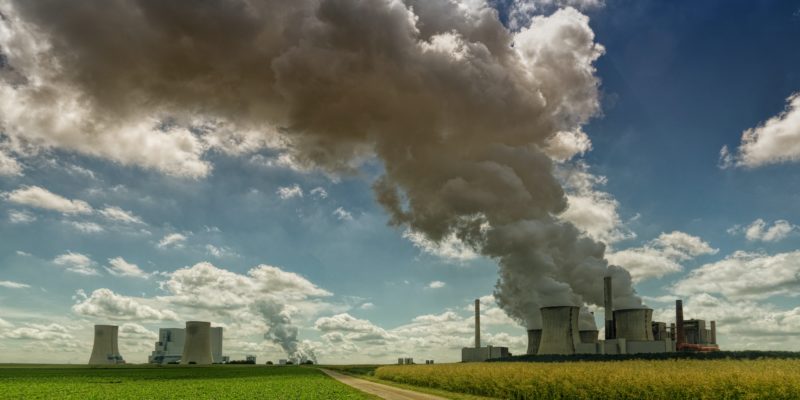Temperature overshoot and tipping points
Without concerted effort to reduce emissions and stop burning fossil fuels now, the world will likely overshoot 1.5°C of warming.

The Intergovernmental Panel on Climate Change (IPCC) – the UN body responsible for climate science – is releasing the first of its three-part 6th Assessment Report (AR6) on 9 August, after a virtual plenary held between 26 July and 6 August. This will be an important media moment. The Working Group I (AR6 WGI) report will be the biggest update of the state of knowledge on climate science since the release of AR5 in 2014, and its three recent special reports (SR1.5, SRCCL, SROCC). The reports are ratified after a plenary negotiation in which governments formally approve the summary for policymakers, ensuring high credibility in both science and policy communities.
The AR6 assessment will consist of three separate reports. ‘The Physical Science Basis’ is the first AR6 report and will detail how the greenhouse gases (GHG) we emit are causing unprecedented damage. The outline for the first report is approved. It will cover topics like extreme weather, human attribution, the carbon budget and feedback cycles, and will chart the current and future state of the climate.
In preparation for the release of the first AR6 report, this briefing covers some of the major climate science developments since AR5 that are relevant to the current science discourse.
Extreme event attribution studies can also tell us if, and how, climate change made a particular extreme weather event more likely or more intense. The expanded attribution literature shows that heatwaves, droughts, tropical cyclones and compound events are directly linked to human activities. In fact, new research has shown that some extreme events would have been impossible without climate change, like the Siberian heat wave in 2020 and the extreme heat across Asia in 2016. Today, scientists can also conduct attribution studies within a few days of an event occurring. One group of scientists published a study showing climate change made the 2018 European heatwave more likely while it was still going on. Another group was able to make an event attribution forecast prior to 2018’s Hurricane Florence.
The COVID-19 pandemic reminded us how much our actions matter: during the peak of global lockdowns daily emissions dropped by 17% compared to 2019, levels not seen since 2006, and people around the world were allowed a short respite from deadly air pollution. Since then, however, emissions have been rapidly ticking up again. Research has shown that the biggest opportunity from the pandemic is not the short lockdown-triggered emissions break, which will be negligible in the long run, but the potential to now tilt the economy towards a green, sustainable, just and climate centered recovery.
Since AR5, we have emitted nearly 300 billion additional tonnes of CO2, bringing us closer to crucial temperature targets. In its 2018 special report, the IPCC predicted that the 1.5°C target would be breached between 2030 and 2052 in the event that we didn’t change our trajectory. Refined methods and research has since suggested that our carbon budget, a simplified (albeit imperfect) way of assessing how much more CO2 can be released, is slightly smaller than estimated in the IPCC report – leaving only 440 Gt CO2
left from 2020 to stand even a 50% chance of 1.5°C. Global emissions were over 40 Gt CO2 in 2019, and if annual emissions are similar in the next decade, the budget will be used up in the 2030s.
The way in which scientists measure global temperature change is also more sophisticated: AR5 based its assessment of historical warming on the UK Met Office’s global temperature dataset, HadCRUT4, now an updated version (HadCRUT5) is available for AR6. The new dataset draws on an improved record of global sea surface temperatures, benefitting from more reliable methods of measuring ocean temperatures, and the record also fills in some of the gaps in Arctic data. The Arctic is the fastest warming region on the planet, so the inclusion of this data increases historic global temperature estimates by about 0.1°C.
Adjustments to the historic warming record may, however, not directly relate to meeting the forward-looking temperature targets of the Paris Agreement. In all previous IPCC assessments there are some scenarios that see us achieve 1.5°C, but the ability to meet this target is driven by the political will and choices of decision-makers, rather than the science itself. It is also difficult to determine at what exact point we exceed a target like 1.5°C. Research from the World Meteorological Organization states there’s a 20% chance that global temperatures could average 1.5°C or above in one of the next five years. But importantly, this should not be confused with exceeding 1.5°C as a long-term average, or breaching the Paris target.
There has also been an increased recognition that abrupt (and sometimes irreversible) changes to the climate, often called ‘tipping-points’, are more likely to occur in a world where we overshoot 1.5°C. Risks include a destabilisation of the polar ice sheets: future sea level rise is very dependent on what happens to the Antarctic and Arctic ice sheets with destabilisation potentially causing tens of centimetres of sea level rise by the end of the century. In addition, deforestation and global warming could increase the risk of the Amazon crossing into a dry state (so-called forest dieback). Researchers have also shown that passing one tipping point could increase the likelihood of others occurring, compounding risks.
Preliminary results from AR6’s new climate models (CMIP6) have already been picked up by the media, due to suggestions that rising CO2 levels will cause more warming than previously thought. Or, in climate science speak, that the Earth has a higher “climate sensitivity”. The Equilibrium Climate Sensitivity (ECS), defined as the warming that occurs when there is double the amount of CO2 in the atmosphere relative to preindustrial times, is a crucial number for understanding climate change.
The ECS describes the final warming after the climate fully adjusts over hundreds of years, and was first estimated at 1.5-4.5°C over 40 years ago. In comparison, the new CMIP6 models produce ECS values between 1.8-5.6°C, but almost all scientists working on the CMIP6 project have now ruled out the highest estimates. Recent research narrowed down the range further and excluded the most extreme values, arguing that the best estimate sits somewhere between 2.6-4.5°C.
Another metric, the Transient Climate Response to cumulative Emissions of CO2 (TCRE), which describes the initial amount of warming we can expect in the coming decades, is more directly relevant to the remaining global carbon budget agreed in Paris. Since AR5, our understanding of the TCRE has expanded, with some model results indicating that it is similar or slightly higher than previous estimates, and new research has narrowed the range by about 30%. Intense debate is ongoing about the exact sensitivity numbers (ECS & TCRE), as well as the uncertainties and how the values influence carbon budgets.
AR6 also draws on new future scenarios, built by teams of economists, climate scientists and modellers. These ‘Shared Socioeconomic Pathways’ (SSPs) explore how global economy and society may change over the next century, allowing a wider range of possible futures and offering a broader view of “business-as-usual” than the ‘Representative Concentration Pathways’ (RCPs) in AR5.
Achieving the Paris Agreement’s goals requires rapid mitigation across the full range of greenhouse gases. Methane and nitrous oxide concentrations are now higher than at any point in the last 800,000 years.
Since the pre-industrial period, CO2 has caused most warming, followed by methane – a particular focus of research in recent years. The concentration of methane is already running well above the safe limits outlined in AR5, increasing steeply since about a decade, and some scientists have suggested that methane’s warming effect is higher than estimated in AR5 (over a 100 year period). Even though there is over 230 times more CO2 in the atmosphere, methane is responsible for almost a quarter of warming. Methane only stays in the atmosphere for about 12 years, but it has a warming potential approximately 30 times that of CO2 over a century, and almost 90 times in a 20-year period.
Human activities were responsible for 50-65% of total methane emissions between 2008-2017, with agriculture and waste contributing most to the rise (56-60%), followed by the fossil fuel industry. But estimating by exactly how much, and from where, methane emissions are increasing is a topic of continued research and debate. Both coal mining and oil and gas production have grown along with methane emissions. By looking at the “atmospheric fingerprints” (isotopes) of methane some researchers have found that the role of North American shale gas – or fracking – has been significantly underestimated. Scientists have also investigated potential natural leaks of methane, and the risk of sudden methane releases from thawing Arctic permafrost.
AR6 will also be the first IPCC assessment to dedicate a whole chapter to so-called “short-lived climate forcers”, like aerosols, particulate matter and other reactive gases (such as ozone) that exist in the atmosphere for a few hours to a few months. In contrast to CO2, mitigating these gases can have an immediate impact on temperature due to their shorter lifetime. Since in most cases their reduction could also improve air quality and save lives, this is seen as a ‘win-win’ policy option.
Half of global GDP is generated in regions that have set (or are debating) net-zero targets, representing over 2.6 billion people. Net-zero is a target guided by science. Studies show that the climate system will continue to warm unless we reach net-zero greenhouse gases globally. Scientists continue to demand net-zero targets that are transparent: asking for them to clarify the scope, fairness and approach. Net-zero targets are in themselves not end-points, but better understood as a milestone on the path to negative emissions and therefore require long-term roadmaps as well as short-term goals.
The refined estimates of Earth’s climate sensitivity has led to some debate about the implications for our timeline to both achieve net-zero and stay below the 1.5 or 2°C temperature targets. But the relationship between these two factors is complicated and indirect. Regardless, scientists continue to stress that the best way to mitigate and avoid the most devastating impacts of climate change is to cut emissions early on and deeply in this decade with the aim of reaching net-zero as early as possible.
So what happens after net-zero is achieved globally? Scientists generally agree that net-zero will lead to a stop in temperature rise. Though models still vary on exactly how long this will take after zero. A cessation in temperature rise, however, must not be confused with a temperature reduction. As CO2 is cumulative, the amount that is in the atmosphere when we hit net-zero will determine peak temperature, unless that CO2 is removed. And even if all emissions stop, ice sheet melting and resulting sea level rise will continue, albeit slower than if we continue warming the planet. As such, the need for adaptation policies and finance, as well as provision for Loss and Damage for poor and affected communities, will remain.
But new research finds that rapid emissions cuts reduce our risks of ‘unprecedented rates’ of warming, which would make it harder for ecosystems and societies to adapt. As such, near term emissions cuts will bring significant benefits within our lifetimes, not just in the long run. To achieve this, however, governments and businesses need to follow ambitious near-term Paris-aligned climate plans.
Pretty much all scenarios that bring us within 1.5°C or 2.0°C rely on some form of carbon dioxide removal (CDR). Methods of removal range from enhancing natural carbon drawdown through reforestation, restoration and the protection of nature, to “negative emissions technology” like direct air capture (DAC) and bio-energy with carbon capture and storage (BECCS).
Our reliance on CDR is however somewhat naive, as all methods of carbon removal come with side effects and tradeoffs that are context and method dependent – such as the huge land areas needed for BECCS, or energy requirements for DAC. Delayed mitigation has increased our dependence on CDR and the simple truth is that the more carbon we emit now, the more we will rely on negative emissions to stay within our target temperatures. It is fundamentally necessary, however, to immediately protect biodiversity, ecosystems and restore nature. Not just for the climate, but also to warden the rich diversity of life on our planet and to maintain people’s livelihoods.
Scientists have studied the so-called “overshoot scenarios”, that see emissions in the near-term compensated by carbon removal that reaches “net-negative” in the latter half of the century. They found that delayed reaction time of several climate processes means even a temporary overshoot of temperature goals will result in more climate change in comparison to no overshoot (i.e. more sea level rise, acidification of the ocean, permafrost loss or perturbation of the carbon cycle).
In the IPCC’s most recent special report (SR1.5), only 9 out of the 222 assessed temperature pathways have no overshoot, and only 44 go over 1.5°C by less than 0.1°C (low overshoot). However, there are no IPCC scenarios that completely guarantee 1.5°C. Even the most ambitious pathways see a 66% chance of keeping global temperature rise to under 1.5°C, meaning that the chances of overshooting is a subject of continued scientific uncertainty.
Finally, there have been several more studies looking at more invasive geoengineering approaches, like solar radiation management. Though these interventions might help to reduce temperatures immediately and regionally, some of them are seen as high risk endeavours with undesired side effects, especially on the water systems and hence food security. Solar geoengineering also brings novel, and unprecedented, social justice and political challenges. It remains to be seen how the IPCC deals with assessing these technologies. The special report on 1.5°C was the first IPCC report to separate solar geoengineering from more “mainstream” carbon removal. We suspect AR6 will continue this split.
The list below summarises some of the important commentaries and scientific papers, focusing on those published in the last two years. It is not a comprehensive review of the scientific literature; think of it as a start. To explore the specific topics further, please refer to the reference lists within these publications.
Explainers and reports
Selected academic research studies and reviews
Explainers and reports
Selected academic research studies and reviews
Explainers and reports
Selected academic research studies and reviews
Explainers and reports
Selected academic research studies and reviews
Explainers and reports
Selected academic research studies and reviews

Without concerted effort to reduce emissions and stop burning fossil fuels now, the world will likely overshoot 1.5°C of warming.

June, July, August, September and October this year were unambiguously the hottest months since records began in the mid-1800s.